|
|
|
Sort Order |
|
|
|
Items / Page
|
|
|
|
|
|
|
| Srl | Item |
| 1 |
ID:
133777
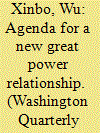

|
|
|
|
|
| Publication |
2014.
|
| Summary/Abstract |
Well begun is half done," Aristotle once said, meaning that beginning a project well makes it easier to do the rest. Yet, this may not be true of China-U.S. relations during Obama's presidency. Although the Obama administration secured a smooth transition from the George W. Bush years and attached high priority to relations with China during its first year in office, bilateral relations turned downward over the rest of Obama's first term, leaving a legacy of growing mutual suspicion and rising competition between the two countries, especially in the Asia-Pacific region. In spite of the November 2009 bilateral agreement to build a "positive, cooperative, and comprehensive relationship,"1 the two sides missed opportunities for more cooperation while mishandling and even misguiding bilateral ties on some points.
|
|
|
|
|
|
|
|
|
|
|
|
|
|
|
|
| 2 |
ID:
079137
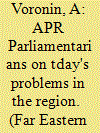

|
|
|
|
|
| Publication |
2007.
|
| Summary/Abstract |
The XV session of the Asia-Pacific Parliamentary Forum (APPF) was held in Moscow on January 22 - 25, 2007. The event was extraordinary not only by parliamentary but also by general Russian standards. For the first time, representatives from the highest legislative organs of 23 countries in the region gathered in Moscow for a comprehensive and thorough discussion of issues of common interest to the nations of the Asia-Pacific Region, and to draft a parliamentary program for joint efforts to combat contemporary challenges and threats
|
|
|
|
|
|
|
|
|
|
|
|
|
|
|
|
| 3 |
ID:
151610
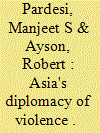

|
|
|
|
|
| Summary/Abstract |
Military coercion has already changed the Asia-Pacific region.
|
|
|
|
|
|
|
|
|
|
|
|
|
|
|
|
| 4 |
ID:
143681
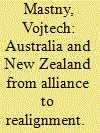

|
|
|
|
|
| Summary/Abstract |
Sino-American debates about the emerging security order in the Asia-Pacific region have not paid enough attention to the perspectives of lesser powers. Among them, Australia and New Zealand, as developed nations increasingly integrated with Asia, are potentially most influential. A historical analysis of their different yet complementary security perceptions and policies suggests diminishing relevance of traditional security structures in the post-Cold War international environment. In the Asia-Pacific region, the established US-centered bilateral alliances are expedient for upholding the status quo, but less so for managing the necessary change. Australia has been at the forefront of promoting the growth of new multilateral regional structures, based on the Association of Southeast Asian Nations (ASEAN), whereas New Zealand has been most successful in developing mutually satisfying relations with China. As desirable strategic partners of both China and the United States, the two middle powers are best suited to promoting a realignment based on common economic interests and values, rather than on balance of power, thus bridging the supposed gap between ‘Asian’ and ‘Western’ values. A Trans-Pacific Partnership including China may eventually become a centerpiece of regional realignment that could serve not only trade but also security by ensuring increasing interaction and understanding among people at all levels―the best safeguard against a slide to military rivalry.
|
|
|
|
|
|
|
|
|
|
|
|
|
|
|
|
| 5 |
ID:
131665
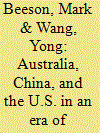

|
|
|
|
|
| Publication |
2014.
|
| Summary/Abstract |
Tensions in the Asia-Pacific region are rising as a consequence of the U.S. "pivot" to Asia and China's increasingly assertive foreign policy. Other states in the region must try to reconcile potentially conflicting economic and strategic imperatives as a consequence. Australia illustrates these dilemmas. We ask what role regional institutions can play.
|
|
|
|
|
|
|
|
|
|
|
|
|
|
|
|
| 6 |
ID:
173190
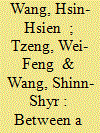

|
|
|
|
|
| Summary/Abstract |
In comparison to hegemony, lesser powers usually struggle for survival between two or more great powers under state power asymmetry, a perpetual phenomenon in international politics. With the rise of China and the increasingly strengthening role of the US in the Asia-Pacific region, it is important to learn how lesser powers manage their relations with the two. To explore this issue, we propose that the strength of state power will constrain the strategies of lesser powers as they choose between the US and China. Borrowing from existing theories and ideas on strategies that include balancing, bandwagoning, and hedging, we argue that the stronger a country’s power, the more likely it will choose a balancing strategy. At the same time, the weaker the country, the more likely that it will go with bandwagoning. Regional middle powers will show varied strategy choices, as they possess a higher degree of freedom in choosing which great power to side with. To validate these arguments, we construct two indicators — differences in trade dependence on the US and China and differences in the voting score consistent with the US and China — to quantify the strategies of lesser powers toward great powers and examine whether the variable of strategies follows the expected pattern. Our analysis shows that countries in the middle of the spectrum of state power demonstrated great freedom in choosing strategies toward the two powers.
|
|
|
|
|
|
|
|
|
|
|
|
|
|
|
|
| 7 |
ID:
019040
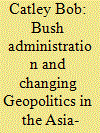

|
|
|
|
|
| Publication |
April 2001.
|
| Description |
149-167
|
|
|
|
|
|
|
|
|
|
|
|
|
|
|
|
| 8 |
ID:
170722
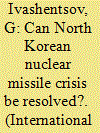

|
|
|
| 9 |
ID:
152277
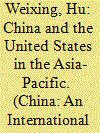

|
|
|
|
|
| Summary/Abstract |
The relationship between China and the United States is one between a rising power and an established power. Whether China is a revisionist power or a status quo power depends on how China and the United States get on with one another in the Asia-Pacific region. The US pivot to Asia and China’s rapid rise has created new dynamics for China–US relations in the region. A changing China–US relationship is also reshaping the strategic landscapes in the Asia-Pacific. US policy towards China has oscillated between containment and engagement since the end of the Cold War. In recent years, this policy has increasingly focused on the “engage but hedge” logic. The Obama administration’s pivot to Asia has rebalanced the focus of the “engage but hedge” policy and put more emphasis on political, economic and security competition with China in the Asia-Pacific region. Despite Xi Jinping’s proposal for a “new model of major power relations” between China and the United States, both countries are actually entering into a “new normal” type of power rivalry in the Asia-Pacific region.
|
|
|
|
|
|
|
|
|
|
|
|
|
|
|
|
| 10 |
ID:
098129
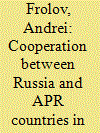

|
|
|
|
|
| Publication |
2010.
|
| Summary/Abstract |
The article surveys international cooperation efforts to dismantle decommissioned submarines of the Russian Pacific Fleet. Russia's difficult financial and economic situation and its inability to dismantle its multi-purpose nuclear submarines forced it to seek assistance from Japan, in which later also joined three other APR countries - Australia, South Korea, and New Zealand. Since cooperative efforts were first launched, foreign funds have been used to dismantle three nuclear submarines, build a radioactive waste processing plant, and a contract has been signed for dismantling two more nuclear submarines.
|
|
|
|
|
|
|
|
|
|
|
|
|
|
|
|
| 11 |
ID:
131314
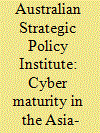

|
|
|
|
|
| Publication |
Australia, Australian Strategic Policy Institute, 2014.
|
| Description |
71p.Pbk
|
|
|
|
|
|
|
|
|
|
|
|
Copies: C:1/I:0,R:0,Q:0
Circulation
| Accession# | Call# | Current Location | Status | Policy | Location |
| 057770 | 005.8095/AUS 057770 | Main | On Shelf | General | |
|
|
|
|
| 12 |
ID:
065376
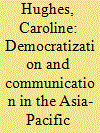

|
|
|
| 13 |
ID:
050382
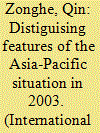

|
|
|
| 14 |
ID:
075474
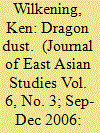

|
|
|
|
|
| Publication |
2006.
|
| Summary/Abstract |
Are scientific or nonscientific factors most influential in initiating international cooperation on newly emerging transboundary environmental problems in the Asia and Pacific region? In a case study of long-range atmospheric transport of dust, which is linked to desertification in China and Mongolia, the relative influence of scientific versus nonscientific factors in promoting cooperation in the Asia and Pacific region is analyzed. The study examines two dimensions of the problem-Northeast Asia and North America-and demonstrates that similar to the distance-dependence of the problem (i.e., dust concentrations decrease the greater the distance from the sources), cooperation follows a parallel relationship (i.e., motivation to cooperate decreases the greater the distance from the sources). Scientific cooperation in Northeast Asia is being institutionalized, but North America has not joined this effort. A synergy between factors must be invoked to explain this situation. In both cases, obvious and often dramatic negative impacts of massive dust storms are an enabling factor allowing more subtle science-related factors to come to the fore.
|
|
|
|
|
|
|
|
|
|
|
|
|
|
|
|
| 15 |
ID:
142918
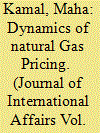

|
|
|
|
|
| Summary/Abstract |
This paper will examine three main pricing mechanisms for gas contracts: oil-indexation, gas-gas competition and netback from final product (e.g. prices linked to Ammonia etc.) in light of the gas contracts in this region that are oil-indexed or linked to oil prices. It will analyze the long term viability and competitiveness of this mechanism for South Asia and discuss natural gas demand in South Asia, conventional and unconventional sources of Natural Gas, as well as the effects of geopolitics in the region on Natural Gas contracts. Remaining cognizant of these developments, this paper proposes the creation of a new natural gas trading hub in South Asia.
|
|
|
|
|
|
|
|
|
|
|
|
|
|
|
|
| 16 |
ID:
135210
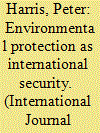

|
|
|
|
|
| Summary/Abstract |
Island bases are integral to US grand strategy in the Asia–Pacific. In this article, I discuss the increasingly common practice of using environmental protection initiatives to secure the Pentagon’s hold on these prized assets. I argue that nature reserves on or around militarized sites on Guam, the Central Pacific islands, and Diego Garcia serve to buttress US political control over the territory concerned. In short, nature reserves in the Pacific and Indian oceans give vital political cover to the island fortresses that they envelop by adding a public relations-friendly rationale for the US military’s occupation of colonized territories as well as an additional layer of politico-legal control.
|
|
|
|
|
|
|
|
|
|
|
|
|
|
|
|
| 17 |
ID:
134033
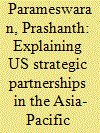

|
|
|
|
|
| Publication |
2014.
|
| Summary/Abstract |
Since the mid-1990s, strategic partnerships have emerged as a new form of alignment between states, particularly in the Asia-Pacific region. Yet only recently has the United States begun to pursue such relationships, especially under the Obama administration which has signed new partnerships with Indonesia, Vietnam, Malaysia and New Zealand. As a result, the current literature does not yet include significant study on how the United States views strategic partnerships. This article attempts to fill this gap by exploring the emergence of strategic partnerships as a new form of alignment in US strategy in the Asia Pacific under the Obama administration. Drawing on the existing literature on alignment, government documents, as well as conversations with policymakers from the United States and Southeast Asia, it argues that Washington is pursuing strategic partnerships as part of a deliberate effort to both enlist target countries to share the burden in addressing challenges and to institutionalize its relationships in the Asia Pacific. It constructs an original three-part analytical framework to understand how US policymakers conceive, craft and evaluate strategic partnerships in the Asia Pacific and applies it to analyse the similarities and differences in US partnerships with Indonesia and Vietnam.
|
|
|
|
|
|
|
|
|
|
|
|
|
|
|
|
| 18 |
ID:
130472


|
|
|
|
|
| Publication |
2014.
|
| Summary/Abstract |
The United States is in the early stages of a substantial national project: reorienting its foreign policy to commit greater attention and resources to the Asia-Pacific region. This reformulation of U.S. priorities has emerged during a period of much-needed strategic reassessment, after more than a decade of intense engagement with South Asia and the Middle East. It is premised on the idea that the history of the twenty-first century will be written largely in the Asia-Pacific, a region that welcomes U.S. leadership and rewards U.S. engagement with a positive return on political, economic, and military investments.
As a result, the Obama administration is orchestrating a comprehensive set of diplomatic, economic, and security initiatives now known as the "pivot," or "rebalancing," to Asia. The policy builds on more than a century of U.S. involvement in the region, including important steps taken by the Clinton and George W. Bush administrations; as President Barack Obama has rightly noted, the United States is in reality and rhetoric already a "Pacific power." But the rebalancing does represent a significant elevation of Asia's place in U.S. foreign policy.
Questions about the purpose and scope of the new approach emerged as soon as Secretary of State Hillary Clinton offered what remains the clearest articulation of the strategy, and first used the term "pivot" to describe it, in a 2011 article in Foreign Policy. Almost three years later, the Obama administration still confronts the persistent challenge of explaining the concept and delivering on its promise. But despite the intense scrutiny and short-term setbacks faced by the policy, there is little doubt that a major shift is well under way. And whether Washington wants it to or not, Asia will command more attention and resources from the United States, thanks to the region's growing prosperity and influence -- and the enormous challenges the region poses. The question, then, is not whether the United States will focus more on Asia but whether it can do so with the necessary resolve, resources, and wisdom.
|
|
|
|
|
|
|
|
|
|
|
|
|
|
|
|
| 19 |
ID:
132075


|
|
|
|
|
| Publication |
2014.
|
| Summary/Abstract |
South Korea's diplomatic and security focus has inevitably been on northeast Asia and its difficult relationship with its northern neighbour, but South Korea also has a role to play in the broader Asian Pacific region. This article analyzes South Korea's increasing economic, political, and cultural links with the wider region, in particular with Southeast Asia, and its role in the development of Asian Pacific regionalism. Utilizing the concept of "middle power," it argues that, while clearly South Korea cannot ignore what is happening in its immediate geographical environment of North-east Asia, it does have the economic and political resources to enable it to take advantage of the opportunities for greater interactions with other parts of the Asian Pacific region, particularly Southeast Asia, if the political will exists.
|
|
|
|
|
|
|
|
|
|
|
|
|
|
|
|
| 20 |
ID:
054587


|
|
|
|
|
|
|
|